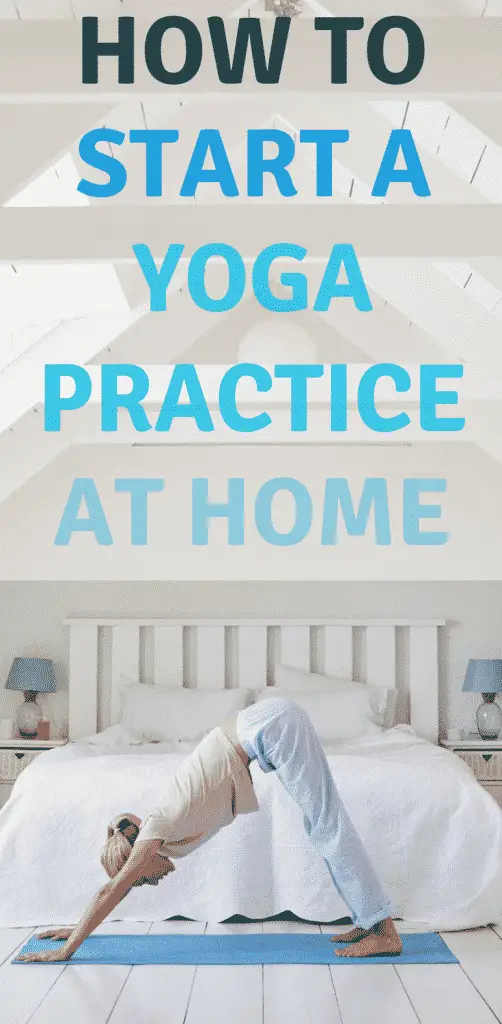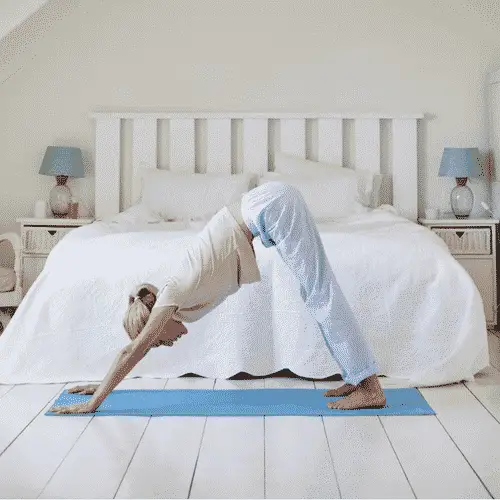 If you’ve wanted to start practicing yoga but you find attending a studio intimidating, you’re not alone. Many yoga devotees experienced that exact same feeling in the lead up to stepping into a yoga studio for the first time.
If you’ve wanted to start practicing yoga but you find attending a studio intimidating, you’re not alone. Many yoga devotees experienced that exact same feeling in the lead up to stepping into a yoga studio for the first time.
And while it can be amazing to practice yoga at a studio that you connect with, one of the many benefits of yoga is that you can do practice it anywhere – that means that you can start a yoga practice at home and reap the benefits.
If you’re unable to attend a yoga studio due to feeling intimidated, the cost, your schedule, etc., then I’m going to show you exactly how to start a yoga practice at home.
Before I get into that though, I want to talk a little bit about WHY you should start a yoga practice, for those who are on the fence.
Millions of people, for thousands of years, have known and experienced the benefits of yoga. And there’s one main reason why this ancient practice has become so incredibly popular – because it works.
Here are just a few of the things yoga can do for you:
- Increase your strength and flexibility
- Increase your stamina
- Improve your focus and concentration
- Help you lose weight
- Help manage stress
- Release tension
So now you know a few of the benefits of yoga, here’s how to start a yoga practice at home:
Create a Space
 It’s important that you create a space for where you’re going to practice.
It’s important that you create a space for where you’re going to practice.
This space doesn’t have to be huge, and it doesn’t have to be fancy. If you have an entire room you can set aside, that’s awesome. But the reality is, most of us don’t.
All you really need is a space that is quiet, has enough room for you to move into various positions, and is convenient.
If you have to move your couch against the wall every time you want to practice, it’s going to reduce the likelihood that you actually practice However, if you truly don’t have any more space, then go ahead and move that couch against the wall! The important thing is that you actually do it.
Buy What You Need (But Don’t Buy Too Much)
The beauty of yoga is that you really don’t need much to practice.
However, you’ll quickly notice that there seems to be an abundance of yoga gear, clothing, etc., that you need. You don’t need all of that stuff to get started, but there are a few items that it’s wise to invest in:
That’s all the equipment you’ll ready need to start a yoga practice at home. As you progress, you might find that you want to invest in some high-quality yoga apparel, various other yoga apparatus, etc., however those things are not necessary to begin.
Set Aside a Time
 While many people enjoy practicing yoga first thing in the morning, there are no rules when it comes to the perfect time to practice yoga.
While many people enjoy practicing yoga first thing in the morning, there are no rules when it comes to the perfect time to practice yoga.
The best time for you to practice is whenever you’ll actually do it.
If this means 9pm, after the kids have gone to bed and you finally have some time to yourself, then that’s perfect.
If you work nights, sleep during the day, and 5pm is the best time for you, then 5pm is perfect.
The key is this: find the time that works for you and stick to it. Make it a priority.
Also remember: while it’s great to schedule a specific amount of time each day to practice yoga, sometimes life gets in the way.
We can’t always control our circumstances, but we CAN control how we react to them.
If something important comes up that is going to eat into your yoga time, don’t just say “I’m not practicing yoga today.” 15 minutes (or even 5 minutes) is better than nothing.
Choose Your Practice
There are many different styles of yoga, and it can be quite overwhelming for the beginner. To make things a bit easier, I’ve broken down 5 of the most popular styles of yoga and their benefits here.
Once you’ve decided on the style of yoga that appeals to you the most, you’ll now need to find a way to follow along.
There are hundreds of yoga videos available on YouTube covering all styles and experience levels. One of my favorite yoga channels is Yoga by Adriene. Adriene has created an amazing 30 Days of Yoga journey which is a perfect introduction to yoga.
Staying Safe and Avoiding Injury
Whenever you start any exercise routine, it’s important to follow a few simple safety precautions in order to help prevent injuries, and yoga is no different.
Trying to do too much, too soon is one of the most common causes of injury. It can be tempting to try and do some of those amazing poses you’ve seen yoga gurus do. But doing those advanced poses before your body is ready is a recipe for disaster.
Many people underestimate just how much of a workout yoga can give. They skimp on their warm up, don’t listen to their body, and often skip their cool down as they run off to get on with their busy day.
Warming Up
It’s important to warm up your muscles in preparation for exercise. Static stretching, i.e., touching your toes or doing calf stretches are good options, but dynamic stretching is even better.
Classic poses like cat cow and sun salutations, done at a gentile pace, are ideal for warming up and increasing flexibility and range of motion.
Yoga Poses
 There are thousands of yoga poses, some requiring more flexibility and having a greater impact on the body than others.
There are thousands of yoga poses, some requiring more flexibility and having a greater impact on the body than others.
Yoga is suitable for people of any age, but it is important to listen to your body and avoid poses that can cause injury.
For example, if you have issues with your knees, squatting poses can cause pain. If you’re pregnant, inverted poses should be avoided.
When it comes to yoga, “no pain, no gain” is completely untrue. Pain is a sign that something needs to be addressed, so make sure you listen to your body. If you’re in pain, move out of the pose.
Cooling down
After each yoga session, it’s important to cool down – your muscles have actually had a pretty intense workout even though you might not have broken a sweat!
Try to do some static stretching, which will help to build longer, leaner muscles, and when you end with savasana (or “corpse” pose) you may wish to cover yourself with a yoga blanket.

